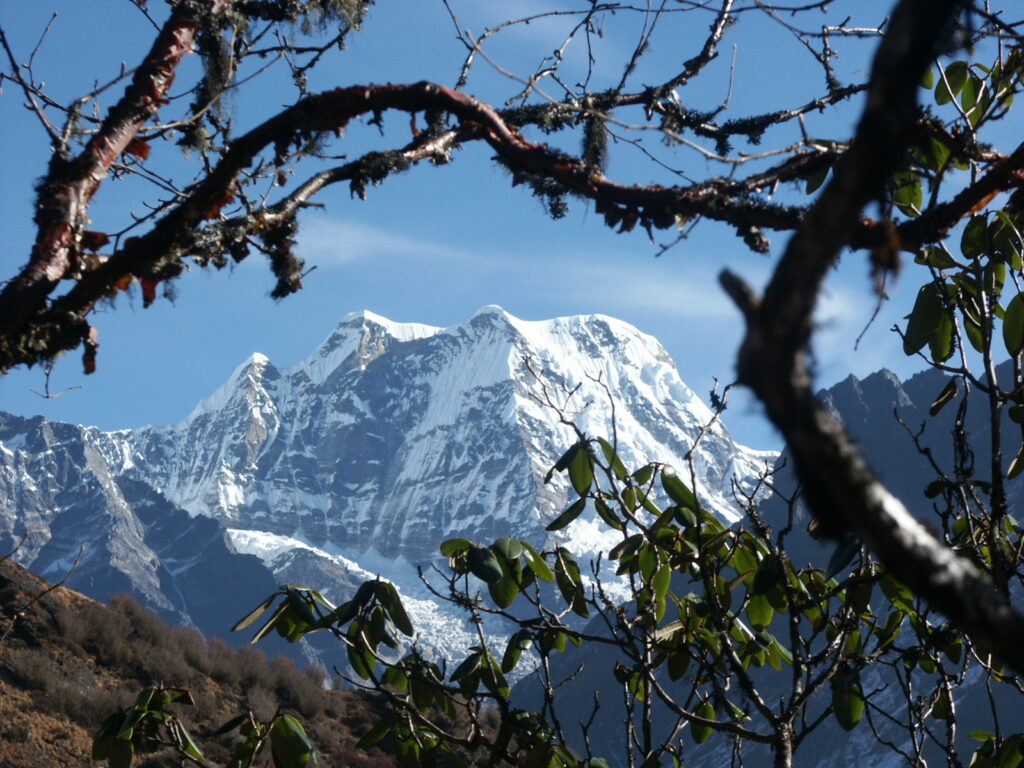Mera Peak (6476m)
Mera Peak (6476m)

Talk With Expert
- +977-1-5591234 / 9851104568
- info@prestigeadventure.com / pdamber@yahoo.com
OVERVIEW
Height (m.) : 6654
Himal : Khumbu Himal
Region : Sagarmatha
Mera Peak (6,654 m) is the highest permitted trekking peak of Nepal. It stands to the south of Everest and dominates the watershed between the heavily wooded valleys of the Hinku and Hongu Drangkas.
J.O.M. Roberts and Sen Tenzing made the first successful ascent of Mera Peak on 20 May 1953. The route they used is still the standard route. There are many other routes to the peak, but none of them are easy. Some of them require crossing very high and difficult passes. This leads to a true mountaineering experience. In the end, all efforts and hard work is paid off with spectacular scenery as Mera provides one of the finest viewpoints in Nepal.
Mera Peak offers a panoramic view of Chamlang, Kangchenjunga, Makalu, and Baruntse in the east and the peaks of Cho-Oyu, Ama Dablam and Kangtega to the west. Everest can be viewed to the north over the massive unclimbed south face of Lhotse and the Nuptse/Lhotse ridge. Under favourable conditions, it is possible to climb the peak and descend back on the same day.
Fee Structure for the Peak
| Group Size | Rate US$ | Additional P/P US$ |
| 1-4 persons | 350.00 only | |
| 5-8 persons | 350.00 plus | 40.00(per person) |
| 9-12 persons | 510.00 plus | 25.00(per person) |
Note : Maximum number of members in team is 12.
ITINERARY
-
Day 1 Arrival in Kathmandu
On a clear day, flying to Kathmandu via Nepal’s northern border is a thrilling and unforgettable experience because you get to see the stunning, expansive panorama of the snow-capped Annapurna mountain range. Your hotel will be escorted to by the Nepali support staff when they receive you at the airport.
-
Day 2 Sightseeing of Kathmandu Valley
Being the historical and cultural center of Nepal, Kathmandu is a favorite travel destination for adventurers, trekkers, and tourists. The city displays a beautiful fusion of Tibetan Buddhism, Hinduism, and Western influence. Its two principal nearby cities, Patan and Bhaktapur, are extremely important in terms of history, culture, and religion. A half-day guided trip will see the well-known and largest Hindu shrine PASUPATHINATH, the town’s largest Buddhist pagoda BOUDHANATH, the palace with 55 windows from the 15th century, and SOYAMBHUNATH. A trip orientation meeting will be held in the evening.
-
Day 3 Flight to Lukla
We fly to Lukla first thing in the morning. We may enjoy the breathtaking vistas of enormous snow-capped mountain peaks while in the air. Outside of one of the numerous lodges, we will spend the night camping.
-
Day 4 Trek to Chutanga
When we get to Lukla, we meet the trekking team. After that, from Lukla, we travel east. The Kalo Himal Ridge route winds through picturesque villages and dense forest. We must adhere to our intended course. Otherwise, we risk straying from the intended course. Snow throughout the winter forces us to navigate rocky terrain. But when the weather is good, the track is typically easy to follow. We reach Chutanga after 3–4 hours of walking.
-
Day 5 At Chutanga
At Chutanga, we stay two memorable nights. This provides us enough time to acclimatize before facing Zatrwa La. We can take a leisurely hike down to a tiny peak at 4000 meters beneath the Zatrwa Teng Pass. As we look across the Dudh Kosi valley and the charming trail zigzagging towards Zatrwa La, wonderful sights open up. Following our exploration, we return to our camp at Chutanga and completely unwind.
-
Day 6 Trek to Tuli kharka
The Kalo Himal Ridge, which divides the Khumbu from the Hinku Valley, is traversed via the path. We continue on a pleasant path that leads past a 4450m-high cairned notch on the ridge that is dotted with prayer flags. Yak herders may be present en route. Both the view across the Dudh Kosi and the view across the undulating slopes east of the Hinku Valley are quite magnificent as they look towards Karyolung and the Lumding Himal. A sizable boulder that designates our campground, Tuli Kharka, may be found 30 minutes below the pass. After 6 to 7 hours of hiking, we arrive at Tuli Kharka.
-
Day 7 Trek to Mosum kharka
The walk descends a slope lined with rocks that leads to a great viewpoint of the Hinku valley and stunning views of Mera Peak’s south face. The trail winds its way through a woodland before dropping abruptly into the Hinku valley. As we take in the beauty of nature all around us from the Hinku Valley, an amazing view of Peak 43 and Kusum Kangguru emerges. As we stroll past pine and rhododendron forests, we feel the most unique and lovely emotions. We established a campground near the banks of Hinku Drangka [river] not long after arriving in Mosum Kharka.
-
Day 8 Trek to Tangnag
The valley widens and the forest closes in as we move north along the west bank of the Hinku Khola. In the Upper Hinku, we see meadows being used as grazing grounds for yaks, sheep, and goats. We approach the summer settlement of Tangnag as we cross a single-plank bridge at Gondishung after multiple ascents that took 4-6 hours. Here, we make a lunch stop. A 200-year-old gompa that is nearby is curled up beneath a huge boulder and several shoddy mani walls. The hike provides a magnificent view of Peak 43.
-
Day 9 At Tangnag
We spend the first two days fully acclimatizing. After getting enough rest, we can consider alternative adventurous options like strolling by Sabal Tsho, a lovely moraine-dammed lake that is concealed behind the Sabal Glacier, or scaling a peak that rises to a height of around 5000 meters. Hinku Nup Glacier, which leads in the direction of Kangtaiga, can also be explored. At Tangnag, the upper Hinku valley makes a U-turn toward the east, traveling over the Dig Glaciers’ moraine.
-
Day 10 Trek to Khare
The track ascends to a broad grassy basin known as Dig Kharka as we move away from Tangnag. We stroll on for several hours. After some time, we reach Khare. There are various campsites at Khare, but the busiest one is near the top of the lake, next to some stones. We decide to set up tent here. This campground offers magnificent views of the enormous Mera North Face, the Hinku Shar Glacier, and Mera La.
-
Day 11 Khare upper end
This day is dedicated to acclimatization. After getting enough rest, we hike up to a tiny mountain on the Hinku Nup Glacier’s western side, where we can ascend to a height of approximately 5500 meters. At this moment, we have the opportunity to take beautiful pictures of Mera La and Mera Peak.
-
Day 12 Trek up to campsite by lower part of Hinku Nup glacier
We proceed down the Mera La route. We keep traversing till we reach the Hinku Nup Glacier’s base. At this moment, the exotic beauty of the snowy slope and the view of the Himalayan peaks capture our attention.
-
Day 13 Rest day
This day has been set aside specifically to give us time to fully acclimate and to get plenty of rest. After unwinding, we receive another jolt to revive our sense of adventure.
-
Day 14 The ascent
After breakfast, at around two in the morning, we make our way towards the peak. We can get up to 6000m by sunrise. We keep trying, and eventually we reach the top. We may enjoy the most breathtaking perspective of at least five of the fourteen 8000-meter summits in the world from the summit. The majority of this breathtaking view is seen from the high camp location, and it is all visible from a height of 6000 meters. We ascend to the campsite on the Hongu side of the pass before descending.
-
Day 15 Return back to Lukla
-
Day 16 Flight to Kathmandu
We get an early-morning flight from Lukla to Kathmandu.
-
Day 17 Depart Kathmandu
We will drive you to the airport so you may catch your journey home with our Nepalese support staff. (Or stay longer for shorter activities like a game drive in a national park, rafting, Tibet tours, or mountain biking, for example).

